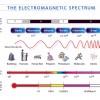X-rays, radio waves and visible light are all examples of electromagnetic radiation (EMR). What is electromagnetic radiation? It is a form of energy that travels in the form of electromagnetic waves, which are created when electricity and magnetism come together.
James Clerk Maxwell first discovered the existence of these waves around 1860, but it wasn’t until
Heinrich Hertz built a device that produced radio waves that their existence was proven. Hertz’ experiment proved not only that electromagnetic waves existed, but that they are a form of light.
How does it work?
Electricity and magnets both emit invisible fields. When those fields change or move together, they form electromagnetic waves. EMR interacts with matter and those interactions can produce electric current and heat.
This radiation can be described of in terms of its wavelength, or the distance between the crests of each wave. Another term that is used to describe it is frequency--the number of crests that pass by at a certain point at a certain length of time. Energy is also a key part of waves. When wavelengths shorten, the amount of energy increases.
Electromagnetic waves are essential to how many of the technologies we use today work, because they can travel through free space. Without it, we wouldn’t have radio, microwaves, X-rays and many other vital tools that we depend upon.

